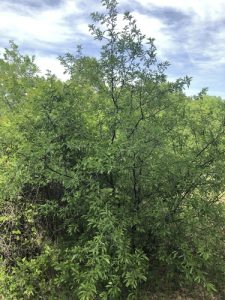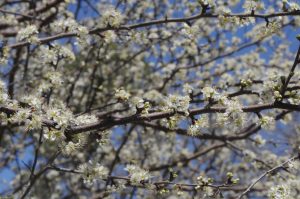
Origins of the Chickasaw Plum
The Chickasaw Plum (Prunus angustifolia) is native to the southeastern United States, including Florida, where it thrives in a variety of habitats such as woodlands, savannas, and along stream banks. It is actually a part of the rose family so watch out for the thorns! Historically, it has been a significant food source for Native American tribes and early settlers due to its edible fruits. Chickasaw Plums are a favorite among local wildlife and are host plants for the red spotted purple butterfly.

Growing Conditions and Characteristics
Chickasaw Plums prefer full sun but can tolerate partial shade. They thrive in well-drained, acidic soils and are drought-tolerant once established. At maturity, the plant will be 12-20 ft in height. These trees grow quickly and are well-suited to USDA Hardiness Zones 7-10. Their growth ranges from a shrub-like form to a small tree, and they’re known for their fragrant white blossoms in early spring and small, tart fruit in summer. The fruit is edible; you can eat the fruit fresh from the tree, dry the fruit, make jelly or wine, or any other creations! If you are thinking about planting one, it is best to do so in the winter.

The Detriment of Invasive Species
While native plants contribute positively to local ecosystems, invasive-exotic species pose significant threats by displacing native flora and disrupting ecological balance. In Florida, invasive species such as Brazilian pepper and cogongrass endanger native habitats, which is why it is important to choose suitable plants for the landscape.

Native plants like the Chickasaw Plum require minimal upkeep, doesn’t need supplement irrigation once established, has low fertilizer needs, and few pests compared to some non-native alternatives such as plums, a cousin to this plant. It’s important to note, however, that not all exotic plants are invasive. There is room for diversity in landscaping and gardeners can incorporate both native and non-invasice exotic plants.

Have a question?
Follow us!
More resources
 3
3
